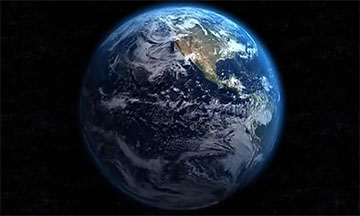Planet earth
Earth science and history
- Lewis Dartnell. Origins: how Earth's history shaped human history. Random House, 2019.
- Lewis Dartnell. Origins: how Earth's history shaped human history. 10 September 2019. 1:11:07. (Conversations at the interval).
- How Earth shaped human history: interview with Lewis Dartnell about Origins.
- Katy Guest. Origins by Lewis Dartnell review: how the Earth made us. The Guardian. 23 January 2019.
Earthrise (1968)
- Earthrise. 100 photos: the most influential images of all time. Time. It includes documentary short: Earthrise. 5:12.
- Ron Garan. I went to space and discovered an enormous lie. Big Think, 2022. 7:37.
Pale Blue Dot (1990)
In the first chapter of his book Pale Blue Dot (1994) Carl Sagan comments on Earthrise, the photograph taken by the Apollo astronauts, "a kind of icon of our age," and explains why he thought another picture of our planet, taken from a hundred thousand times farther away, would help us understand our true position in the universe:
From this distant vantage point, the Earth might not seem of any particular interest.
But for us, it's different. Look again at that dot. That's here. That's home. That's us. On it, everyone you love, everyone you know, everyone you ever heard of, every human being who ever was, lived out their lives. The aggregate of our joy and suffering, thousands of confident religions, ideologies, and economic doctrines, every hunter and forager, every hero and coward, every creator and destroyer of civilization, every king and peasant, every young couple in love, every mother and father, hopeful child, inventor and explorer, every teacher of morals, every corrupt politician, every "superstar," every "supreme leader," every saint and sinner in the history of our species lived there—on a mote of dust suspended in a sunbeam.
The Earth is a very small stage in a vast cosmic arena. Think of the rivers of blood spilled by all those generals and emperors so that, in glory and triumph, they could become the momentary masters of a fraction of a dot. Think of the endless cruelties visited by the inhabitants of one corner of this pixel on the scarcely distinguishable inhabitants of some other corner, how frequent their misunderstandings, how eager they are to kill one another, how fervent their hatreds.
Our posturings, our imagined self-importance, the delusion that we have some privileged position in the Universe, are challenged by this point of pale light. Our planet is a lonely speck in the great enveloping cosmic dark. In our obscurity, in all this vastness, there is no hint that help will come from elsewhere to save us from ourselves.
The Earth is the only world known so far to harbor life. There is nowhere else, at least in the near future, to which our species could migrate. Visit, yes. Settle, not yet. Like it or not, for the moment the Earth is where we make our stand.
It has been said that astronomy is a humbling and character-building experience. There is perhaps no better demonstration of the folly of human conceits than this distant image of our tiny world. To me, it underscores our responsibility to deal more kindly with one another, and to preserve and cherish the pale blue dot, the only home we've ever known.
[Carl Sagan. Pale blue dot: a vision of the human future in space. New York: Random House, 1994, p. 6-7.]
- Carl Sagan unveils the Pale Blue Dot image. 6 June 1990. 1:35.
- Nadia Drake. The first person to see the 'Pale Blue Dot' image still has it stashed in her closet. 14 February 2020.
Long and short numeric scales
- English numerals. Wikipedia, the free encyclopedia.
- List of SI prefixes. Wikipedia, the free encyclopedia.
- Liz Walter. 1066 and all that: how to say years. About words: a blog from Cambridge dictionary. 4 October 2017.
- John M. Becker. The 100 most important events in human history.
Human evolution
Humanity's African origins
- Kate Wong. How scientists discovered the staggering complexity of human evolution. Scientific American. 1 September 2020.
Nanotechnology
- Themis Prodromakis. Five ways nanotechnology is securing your future. The conversation. 22 March 2016.
Creation-evolution controversy
- David Masci. Darwin in America: the evolution debate in the United States. 6 February 2019.
Time management
Time management tips
- Sean Cope. Eighteen effective time management strategies and techniques. Upwork. 1 Apr. 2021.
- Lian Parsons. Eight time management tips for students. Harvard Summer School, 14 Oct. 2022.
- Time management tips for busy college students. Purdue Global, 19 Apr. 2018.
